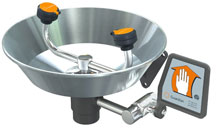



Find all of your laboratory and workplace safety supplies at Safety Emporium!
 Autoignition |
 Glossary Index |
 Baumé Scale |
| MSDS Topics |
Free Sites | FAQ's | Regulations | Glossary | Software | Suppliers |
| Books | Forum | Poll | Fun stuff | Quiz | Store | |
| Understand your MSDS with the MS-Demystifier | Search ALL our MSDS info | |||||
There are several definitions for base:
There are several other (very technical) definitions, but those are beyond the scope of what one usually sees on a Safety Data Sheet.
A basic solution is defined as one that has a pH greater than 7.0. Basic materials or solutions are sometimes called caustic or alkaline.

Protect your employees with cabinet labels from Safety Emporium.
The following are examples of strong bases, meaning that they completely dissociate into ions and form OH- in aqueous (water) solution. For example, NaOH → Na+ + HO-. All of these will cause severe burns upon skin contact:
| Formula | Name |
| NaOH | Sodium hydroxide |
| KOH | Potassium hydroxide |
| Ba(OH)2 | Barium hydroxide |
| Ca(OH)2 | Calcium hydroxide |
Weak bases do not dissociate completely to form hydroxide (OH-) ions in water. Examples of these include ammonia (NH3), amines, fluoride ion (F-), and acetate ion (CH3COO-). Water can also act as a weak acid or base.
Here is a representative example of a chemical reaction of a weak base in water. The two arrows below are together called an equilibrium arrow, which means that the reaction takes place in both directions simultaneously and at some point the concentration of each component will a steady value.
NH3 + H2O  NH4+ + OH-
NH4+ + OH-
Just because an base is weak does not mean that it can't harm you. For example, ammonia can cause severe burning of the lungs and death if enough is inhaled and is extremely irritating to the eyes.
It is important to know the pH of substances because they may be corrosive or react with incompatible materials. For example, acids and bases should not be stored or used near each other as their accidental combination could generate a huge amount of heat and energy, possibly resulting in an explosion. The pH of a substance (if applicable/known) will be found in Section 9 (physical and chemical properties) of the Safety Data Sheet and warnings about incompatibility will found in Section 10 (stability and reactivity).
pH is also important to know in case you spill the material on your skin or eyes. Whenever a substance enters the eyes, flush them with water for 15 minutes, preferably with an ANSI-approved eyewash unit. Most bases have a very strong affinity for eye tissue and may not be fully flushed from the eye even with such first aid treatment, so always consult a medical professional after such exposure. Take the SDS with you to the emergency room, if possible, to minimize any treatment delays.

Safety Emporium carries all kinds of eye/face washes, safety showers, drench hoses and more.
Additional definitions from Google and OneLook.
Entry last updated: Monday, March 28, 2022. This page is copyright 2000-2025 by ILPI. Unauthorized duplication or posting on other web sites is expressly prohibited. Send suggestions, comments, and new entry desires (include the URL if applicable) to us by email.
Disclaimer: The information contained herein is believed to be true and accurate, however ILPI makes no guarantees concerning the veracity of any statement. Use of any information on this page is at the reader's own risk. ILPI strongly encourages the reader to consult the appropriate local, state and federal agencies concerning the matters discussed herein.